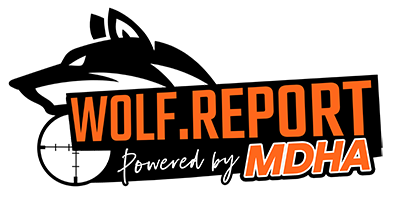

Minnesota has one of the most stable wolf populations in the lower 48, and our state already has a full, science-based management framework in place. Yet despite that, Minnesota cannot currently hold a wolf hunting or trapping season because wolves remain under federal protection.
Recently, the U.S. Fish & Wildlife Service (USFWS) announced that it will not create a national wolf recovery plan. That decision raised an important question:
To put it simply:
It moves responsibility back toward the states and signals that Minnesota’s Wolf Management Plan is more important than ever.
But it does not automatically delist wolves or allow a season. Instead, it prepares the ground for eventual state-based management once federal restrictions are lifted.
Here’s what happens next.
USFWS choosing not to create a national recovery plan is a strong indicator that the agency believes wolves in the Great Lakes region are recovered. However, wolves in Minnesota remain federally listed under the Endangered Species Act (ESA).
Until delisting occurs:
The USFWS decision is a step toward delisting, but it is not delisting itself.
Delisting could happen via:
Once delisted, Minnesota gains full management control.
The Minnesota Wolf Management Plan was designed specifically to function regardless of federal status. Now that the USFWS is shifting responsibility away from a national approach, Minnesota’s plan becomes the primary management document.
Once federal restrictions lift, the DNR will:
Minnesota is prepared — the plan already outlines how to responsibly manage wolf populations with a regulated season when appropriate.
The plan includes a complete decision-making structure for creating a hunting and trapping season. This includes:
Minnesota has already proven it can manage a wolf season safely and responsibly (2012–2014).
Minnesota must consult with tribal governments before finalizing any wolf season.
Consultation is:
This step ensures tribal input is part of the process, particularly in regions where wolves have cultural significance.
Before a season can start, the DNR must:
This typically takes 2–4 months.
After all legal steps are complete, Minnesota can announce its season with:
Everything needed to run a season exists — we just need the green light from the federal level.
It means this:
The bottom line is that Minnesota is ready.
The framework is built.
Science supports it.
The public in northern Minnesota is asking for it.
Now we wait for the federal government to take the final step — delisting — so Minnesota can implement a responsible, regulated wolf hunting and trapping season that protects deer populations, reduces conflict, and reflects on-the-ground reality across the state.
Minnesota’s deer hunters have always been at the center of conservation and wildlife stewardship. When it comes to restoring wolf management, your involvement matters more than ever. Here are the key actions hunters should begin taking immediately—and continue once wolves are federally delisted—to help bring balanced, science-based wolf management back to Minnesota.
Every sighting strengthens the case for management.
Submit reports with photos whenever possible to Wolf.Report and encourage others to do the same. The more real-world data available, the harder it is to dispute the need for management.
Your elected officials need to hear directly from Minnesota deer hunters.
Tell them you support a state-managed wolf season, targeted management zones, and science-based decision-making. A short phone call or email makes a significant impact.
Groups like MDHA, SCI, Backcountry Hunters and Anglers, and local sportsmen clubs work year-round to advance wildlife management. Join, renew, volunteer, and participate. Unity strengthens our influence.
After delisting, the Minnesota DNR will shape the structure of a future wolf season. Hunters must show up, comment, and stay involved in the process. Public input will determine how hunt areas, quotas, and trapping rules are set.
Keep track of trail camera photos, deer movement changes, wolf tracks, and depredation evidence. Hunters see things every day that agencies will never witness without your input.
Most Minnesotans are not anti-hunting—they’re simply uninformed. Calm, fact-based conversations about wolf impact, fawn recruitment, herd health, and the need for balance help build broad public support.
When wolves are delisted, court challenges are almost guaranteed. Support the organizations that will defend delisting and prevent anti-hunting groups from undermining management.
Whether you prefer a crossbow, compound, rifle, or muzzleloader—we’re all on the same side. Internal fighting only empowers those opposed to hunting. A strong, united hunting community is essential for restoring a wolf season.
